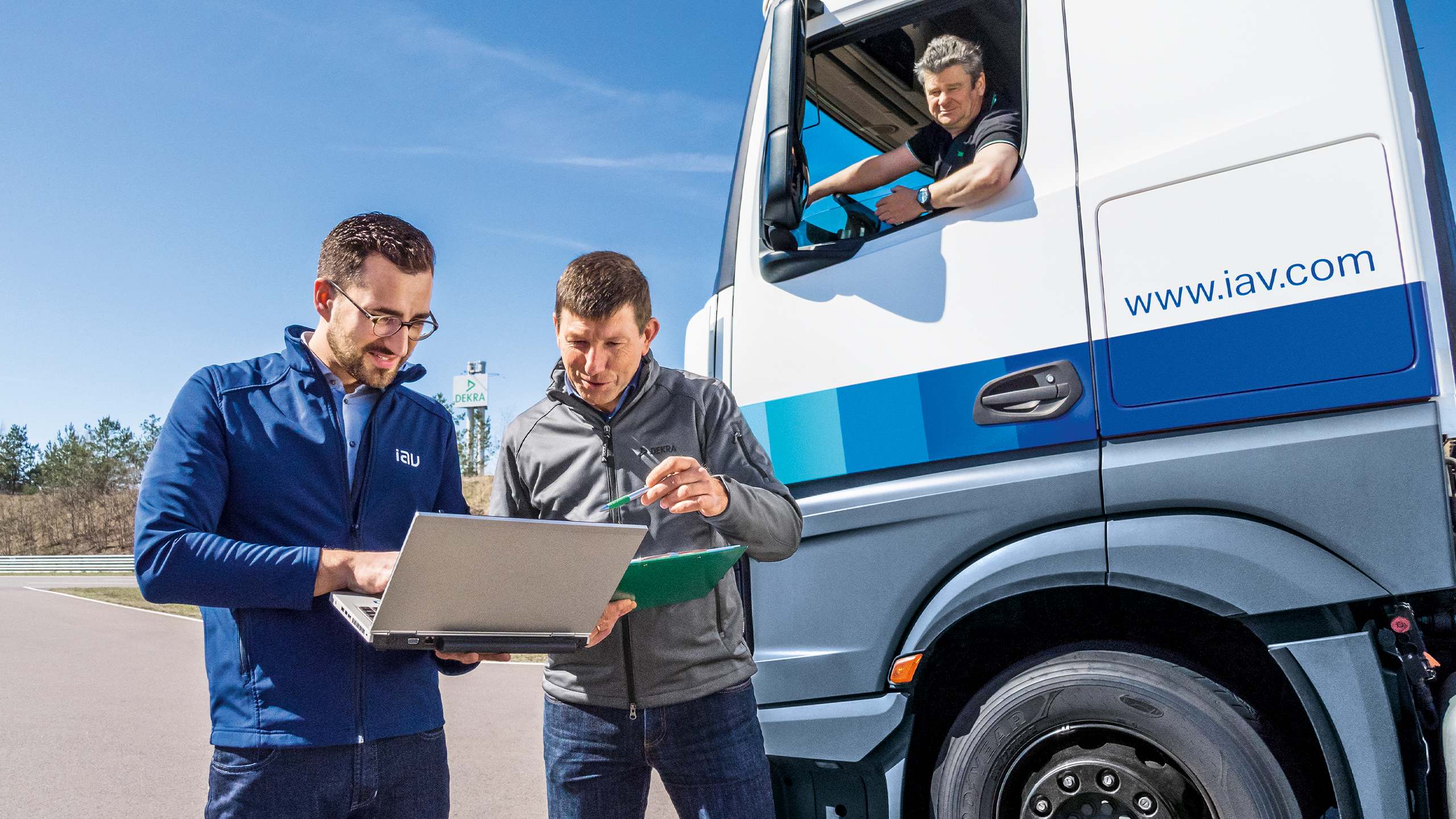Measuring Road Resistance of Commercial Vehicles
IAV in cooperation with DEKRA: taking care of the entire measurement process for determining road resistance coefficients
A new EU regulation will soon make it necessary for all manufacturers of commercial vehicles to specify CO2 values for their products. At the DEKRA test track in Klettwitz, IAV and DEKRA are offering to determine road resistance coefficients and to confirm that they have been determined in conformity with the regulation. On request, the partners will even cover the entire weather and measuring-equipment risk.
For passenger cars, the CO2 emission per kilometer has long been one of the compulsory details that a manufacturer is required to provide. In future, the purchasers of commercial vehicles are also to be given the opportunity to compare fuel consumption and, with this, the carbon-oxide emission from the various models. However, unlike the car, this will not be determined on the basis of a cycle on the chassis dynamometer but using a special approach: “It combines measurements and simulation”, reports Tobias Töpfer, manager of the System Simulation and Testing team at IAV. “Besides the components of the powertrain, measurements also include road resistance, with Annex VI of EU Regulation 595/2009 defining exact specifications on the boundary conditions and procedure of the so-called constant-speed measurements.”
For instance, the track must be dry, the asphalt cooler than 25 degrees Celsius and wind speed slight – this is why most measurements take place in the period between April and October (dry) and at night (not too hot, little wind). An anemometer on the test vehicle measures wind speed, and temperature sensors determine how warm the air and asphalt are. Special measurement wheels provide the torque the vehicle transmits to the road. Information is also recorded from the CAN bus, such as current road speed and the gear selected.

Exact procedure for measuring drag and road resistance
The entire measurement process takes approximately 90 minutes and follows a set pattern that produces the vehicle’s road resistance coefficients. Before the measurement process begins, the commercial vehicle must be allowed to warm up for a period of 90 minutes and the anemometer for measuring air speed must be calibrated. The technicians then set the torque measurement wheels on the drive axle (duration: no more than ten minutes) to the neutral position. This is followed by a further ten-minute warm-up at top speed.
Now the actual measurements can begin, In the low-speed test at 10 to 15 kilometers an hour, road resistance is determined. This is followed by a further warm-up phase of at least five minutes after which the driver accelerates for the high-speed measurements. A further low-speed test at the end of the measurement sequence delivers new values for road resistance which can be compared with the previous results. At the end, the torque measurement wheels are tested.
Cooperation between two strong partners
With its 5,800-meter test track, the DEKRA Automobile Test Center in Klettwitz (Brandenburg) provides ideal conditions for this purpose. IAV and DEKRA offer to measure the road resistance coefficients in the form of a joint service as part of an exclusive cooperation arrangement: “We take care of the entire process, from collecting vehicles and fitting them out with the measuring equipment to performing and documenting the measurements”, Töpfer says.
“At the end, the customer receives all of the results and, on request, is given confirmation by
DEKRA that the measurement results were determined in conformity with the rules and can be used as specified in the regulation.” IAV is responsible for selecting the correct measuring equipment whereas DEKRA takes care of installing it and provides the test drivers.
The raw data from the measurements are prepared by IAV for the “AirDrag tool” provided by the EU – on this basis, it delivers the vehicle specific product of drag coefficient and vehicle frontal area. This, in turn, is fed into the EU’s “Vecto” tool which combines the measured values with other data – such as on the engine and transmission – as the basis for calculating the CO2 emission per kilometer.
Neutral measurements at calculable costs
“It may make sense for a manufacturer not to conduct the measurements itself but to leave this to an independent third party – this ensures the neutrality of results”, Töpfer says. “IAV offers its services as a neutral partner. We also know the test track in Klettwitz very well and can be on site with our measurement teams in about an hour.”
On request, IAV and DEKRA will also completely cover the weather risk for their customers: “It is altogether possible that an OEM rents the test track for a specific time and sends material and staff on a costly journey to Brandenburg but can’t carry out any valid measurements because of rain or other weather conditions”, Töpfer says.
“This is why we offer a version of our service in which we guarantee valid measurement values at a set price. Here, we can take advantage of our good contacts and geographical proximity to DEKRA in Klettwitz as an added benefit for the customer.” Alternatively, customers can also simply ask IAV and DEKRA to perform the measurements and bear the weather risk themselves.
